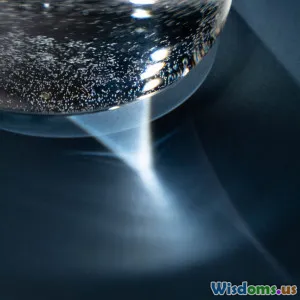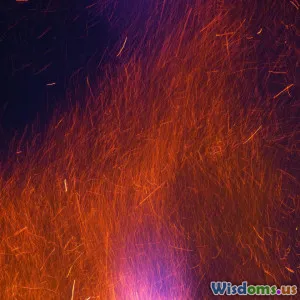
Unexpected Places to Find Water in Arid Landscapes
10 min read Discover surprising sources of water hidden in arid landscapes and learn how nature and ancient techniques reveal life-saving hydration spots. (0 Reviews)
Unexpected Places to Find Water in Arid Landscapes
Water scarcity is a defining challenge in arid regions, where precipitation is infrequent and evaporation rates are high. Yet, for indigenous peoples, survivalists, and explorers alike, the desert is not always a barren wasteland devoid of liquid resources. Beneath scorching sands and unforgiving rock lie unexpected water sources—hidden reservoirs shaped by nature and human ingenuity alike. This article explores these surprising places to find water in arid landscapes, combining scientific insights, real-world examples, and practical applications for anyone venturing into dry environments.
Introduction: The Paradox of Desert Water
Deserts conjure images of endless dunes, sun-baked rocks, and cracked earth craving rain. However, those who truly know deserts understand the paradox: water is there, but it’s often secretive—disguised in unexpected forms or uneroded by clever ecosystems and human adaptation.
Finding water in deserts has been a matter of survival for centuries. Nomadic tribes like the Bedouins in the Arabian Peninsula or the San people of the Kalahari have mastered ancient knowledge of water sources that appear invisible to outsiders. Modern science and technology now decode these natural phenomena, offering insights beneficial not only to survival but also to sustainable water management and desert ecology.
1. Dew and Fog Collection: Nature’s Moisture Harvest
One of the most surprising natural sources of water in arid zones is atmospheric moisture collected as dew or fog. Although seemingly minimal, dew can provide significant hydration over time.
Dew Formation:
At night, cooler temperatures cause moisture in the air to condense on surfaces like rocks, plant leaves, and man-made containers. This water can be harvested by wiping it off leaves or collecting it from dew traps.
- Example: In the Namib Desert, some beetle species, like the Namib Desert beetle (Stenocara gracilipes), harvest dew using bumpy shells that attract moisture from fog rolling in from the Atlantic Ocean.
Fog Nets:
Several arid coastal regions utilize fog collection nets to trap airborne moisture.
- Real-world application: In Chile's Atacama Desert—the driest desert on Earth—fog nets have been installed to intercept fog moisture, supplying up to 5% of the local community’s water needs. These nets can capture about 200 liters of water per day in ideal conditions.
This method is not just ecological but sustainable, showing how water can be painstakingly extracted without relying on groundwater or rainfall.
2. Rock Crevices and Canyon Pools: Nature's Reservoirs
Arid landscapes often have rugged geological structures where water clandestinely pools or is shielded from evaporation.
Rock Crevices:
Water can collect within small cracks and depressions in rocks after rare rainfalls or condensation. These crevices protect the water from direct sun, reducing evaporation.
- Example: The indigenous peoples of Australia have historically relied on “soak wells,” deep crevices where water collects, sometimes hundreds of meters below the surface.
Canyon Pools and Tarns:
Natural depressions in canyons act as miniature reservoirs.
- Case Study: In the American Southwest, particularly in the Grand Canyon and Zion National Park, explorers and local tribes have reported discovering isolated pools, known as “tinajas,” which can hold rainwater for days or weeks. These serve as critical water points for wildlife and humans.
Extracting water from these sites requires care—checking for contamination and minimizing disturbance to fragile ecosystems.
3. Plant Sources: Vegetation as a Water Reservoir
Plants possess remarkable adaptations to store and produce water even in the most punishing debris.
Succulents and Cacti:
These plants store water in their thick, fleshy tissues.
- Example: The barrel cactus (Ferocactus species) stores water that can be extracted during survival emergencies by cutting into the flesh. However, some cacti also contain alkaloids or acidic compounds, so knowledge of local species is essential.
Roots and Tapping Techniques:
Some acacia trees and desert shrubs have deep roots that reach underground water sources.
- Traditional knowledge: The Fulani people of the Sahel region harvest water from roots by digging near tree bases.
Edible Water-Rich Plants:
Certain desert plants, like prickly pear (Opuntia), provide moist, edible pads.
Scientific research shows that some desert plants’ mucilage also has hydrating properties that ancient communities integrated into their diet and water-fetching strategies.
4. Underground Water: Accessing Hidden Aquifers and Water Tables
Water often extends beneath deserts, storing in aquifers far below the surface, sometimes accessed through wells or natural springs.
Ancient Subterranean Water Systems:
The qanat system—ancient Persian technology—tapped underground water by digging gently sloping underground tunnels to transport water from water-rich areas to arid zones.
- Example: Iran, Oman, and parts of North Africa use qanats for irrigation and drinking water, showcasing thousands of years of sustainable water management.
Desert Springs:
Springs emerge where geological conditions bring water to the surface.
- Case Study: The Oasis of Siwa in Egypt depends on natural springs that flow from fossil water reserves under the Libyan Desert, enabling human settlement and agriculture in an otherwise hostile environment.
Modern Well Drilling:
Technological advances allow drilling deep wells into fossil aquifers, but such use requires careful management to avoid depletion.
Data from the U.S. Geological Survey reports that even deserts hold significant underground water volumes, but many aquifers degrade without recharge, linking back to climate change concerns.
5. Solar Stills and Artificial Water Collection Methods
When natural sources are scarce or too complex to locate, technological ingenuity creates water retrieval methods utilizing everyday physics.
Solar Stills:
Solar stills use evaporation and condensation to purify water or generate it from damp soil or plant materials.
-
How it works: A container covered with a clear plastic sheet concentrates solar heat, evaporating moisture, which then condenses on the underside and is collected.
-
Use in Survival: Military and desert survival guides recommend solar stills as a last resort when no visible water is available. Though slow, stills can produce small but consistent amounts of drinkable water.
Collection from Soil and Clay:
Some desert soils contain moisture that can be extracted by burying plastic bags over moist vegetation or digging shallow pits overnight.
- Scientific findings: Researchers in Australia measure soil moisture at various desert sites showing exploitable resources under specific conditions.
These techniques integrate both physical principles and keen observation, providing options where natural retrieval is difficult.
Conclusion: Rethinking Water in Arid Environments
Arid landscapes challenge life with extreme heat and scarce water, but nature and humanity have long adapted to these conditions in ingenious ways. From harvesters capturing fog droplets to hidden canyon pools, and from succulent plants to underground aquifers accessed by ancient tunnels, water persists—even when it seems impossible.
Understanding these unexpected water sources deepens our respect for desert ecosystems and the cultures shaped by them. It also highlights the urgency to protect and sustainably manage these resources amid rising global water scarcity.
For adventurers, locals, and environmentalists alike, exploring and harnessing arid-land water requires knowledge, respect, and innovation. By learning where and how to find water in the desert’s most unexpected places, we not only preserve life—we uncover the remarkable resilience and subtle secrets of one of Earth’s toughest environments.
References & Further Reading
- National Geographic, "Water in the Desert: How Organisms Thrive in Extreme Environments"
- U.S. Geological Survey, "Groundwater in Desert Regions"
- FogQuest, "Fog Collection for Water Purposes"
- Australian Desert Knowledge Cooperative Research Centre, "Desert Plant Water Strategies"
- UNESCO, "Qanats and Ancient Water Management Systems"
This article enriches your understanding of hidden desert waters, inspiring both practical survival skills and deep appreciation for Earth's water cycles.
Rate the Post
User Reviews
Other posts in Water Conservation
Popular Posts
















